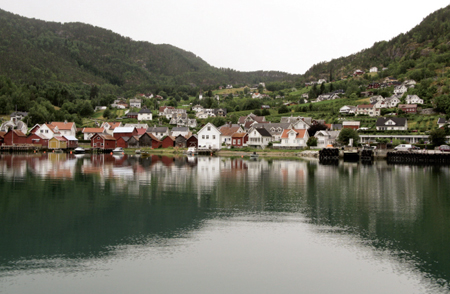My Norwegian dreams began when I was a boy. I followed the adventures of the mighty Thor in Marvel Comics, played Edvard Grieg’s piano music and read mythical tales about gnomes and trolls. I long envisioned standing atop a granite peak, staring out over icy waters straight into the midnight sun, so when I arrived in Oslo in mid-July for a journey to the fantastic western fjords it was more than just a summer vacation—it was a melding of fantasy into reality.
Norway is a land of epic beauty and simple pleasures. Glaciers sculpted the terrain over millennia into a majestic convergence of ice, water, mountain and sky. With such a wilderness as their backyard, it’s no surprise that Norwegians are great outdoor enthusiasts. Summer offers ample opportunity to join their migration across this staggeringly beautiful landscape.
To find my way through the country, I opted for the alliteratively named “Norway in a Nutshell” excursion, a self-guided tour via train, ferry and bus into fjord country. The highlight of the route is the Flam Railway, a train ride that drops 3,000 feet in 12 miles. My inner child imagined a careening ride down the mountain at breakneck speed, but the train’s five braking systems ensured a measured pace and the ride itself wasn’t as thrilling as the scenery we passed—secluded valleys, steep mountains, waterfalls gushing in balletic free fall from dizzying heights.
At Flam, I left my fellow passengers and headed for Balestrand, located near the midway point of the Sognefjord, Norway’s longest and deepest fjord. Spread out on a promontory beneath a panorama of glaciated mountains, Balestrand is a laid-back artist and farming village whose friendly residents appreciate any attempt by a visitor to speak Norwegian (a simple takk, or thank you, goes a long way).
Sights worth seeing include the dragon-winged St. Olaf’s stave (medieval post-and-beam) church, a set of 900-year-old Viking burial mounds, and Kviknes Hotel, a grand “Swiss-style” bed-and-breakfast resort. Balestrand’s main allure, though, is its setting and the lingering summer light that blurs the distinction between day and night and lends a dreamlike quality to everything you see.
Mill Valley resident Unni Marie Kvikne and her husband, Eric Palmer, have an interest in Kviknes, which has been in Unni’s family since 1877. “It’s different every day,” she says. “There’s something about the way the light changes or when a storm passes and sunlight beams through the clouds and leaves behind a rainbow. You never get sick of it.”
Over four days I savored the sun-burnished land from above and below, meandered about boggy, blueberry-lined trails for postcard views, boated across the fjord or lolled near shore. The Gulf Stream keeps the water temperature in the upper 60s, hardly balmy, but warm enough for a refreshing swim. I also cycled to leafy Dragsvik peninsula, which juts into Fjaerlandsfjord, a brooding gorge, then idled near the village of Ese, staring into glassy waters that reflected the pyramid-shaped Vindreken peak.
Jostedalsbreen glacier, continental Europe’s largest at more than 300 square miles in area, was an easy day trip. From afar, the Nigardsbreen arm of the glacier stood immobile, a primordial, frozen, blue-flecked flow; up close, it was alive—melting, dripping, in constant motion. The three-hour guided ice walk I booked started with an admonition: one false move and the tethered 10 of us would plummet into the glacier-fed lake below. The warning, sobering as it was, didn’t dampen our giddiness as we crunched ever higher over the glistening surface and through narrow caverns, all the while marveling at the shifting shades of blue in every crack and crevasse.
After Balestrand, I backtracked to Aurland and set out on a strenuous two-hour hike to the Aurland Lookout, an architecturally stunning wooden platform built in 2006 that protrudes out 100 feet over a spectacular wooded gorge with nothing but an angled sheet of glass to keep the overly curious from falling into the teal-blue waters of the Aurlandsfjord far below.
Next came tiny Undredal, wedged in a fertile valley across from Aurland and famous for its church and its cheese. Parts of the 40-seat, red-roofed stave church date back to 1147. Undredal’s residents, outnumbered by goats nearly four to one, still use ancient methods and goat’s milk to produce geitost, Norway’s popular brown cheese, which looks like a block of peanut butter but has a sweet, caramel-tinged flavor.
I then rejoined the ferry leg of the Nutshell tour for a cruise down the Naeroyfjord, a World Heritage geographic site and Norway’s narrowest fjord, with some passages less than 1,000 feet across and cliffs towering more than 5,000 feet. The boat disembarked at Gudvangen, where I rented a kayak and paddled into the fjord, inwardly humming Grieg’s “In the Hall of the Mountain King” and imagining bearded trolls watching from hidden caves high above.
A final train ride took me to Bergen, a gem of a city with a lively fish market, bustling cafes and another World Heritage Site, Bryggen, the old wharf. This cobbled medieval quarter with colorful wooden harborside houses reflects Bergen’s days as a maritime center in the erstwhile trade alliance called the Hanseatic League. The infamous rain that Norwegians warned would greet me here never came. On a near-cloudless day, I rode the city’s glass-roofed funicular up to Mount Floyen, where a platform 1,000 feet above Bergen provided the perfect place for a final view of Norway’s marvelously serrated shore.
CAPTIONS: (Middle) The Bergen-Oslo Railway meets the Flåm Railway at the mountain station of Myrdal, where excited tourists eagerly await the arrival of the Flåm train. (Bottom) Tjugum Church, dating from 1863, is one of three Church of Norway churches within the municipality of Balestrand.


